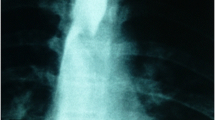Abstract
An aberrant right subclavian artery is a branching variation of the aortic arch. We encountered two female cadavers with an aberrant right subclavian artery during routine student dissection at our school. In both cases, the right subclavian artery was not a branch of the brachiocephalic trunk but originated directly from the distal part of the aortic arch as the last branch and ran between the esophagus and vertebral column, traveling to the upper limb. The right recurrent laryngeal nerve was absent, but a non-recurrent inferior laryngeal nerve branching from the vagus and traveling directly toward the larynx was observed. In the first case, the right and left common carotid arteries originated solely from the aortic arch as the first and second branches, respectively, whereas the right and left common carotid arteries formed a bicarotid trunk at their origin in the second case. A Kommerell diverticulum was present at the base of the aberrant right subclavian artery in the second case, but not in the first case. We analyzed the anatomical differences between the two cases and discussed the developmental aspects and potential clinical risks.


Similar content being viewed by others
References
Adachi B (1928) Das Arteriensystem der Japaner, Bd. 1. Maruzen, Kyoto, pp 35–41
Aizawa Y, Isogai S, Izumiyama M, Horiguchi M (1999) Morphogenesis of the primary arterial trunks of the forelimb in the rat embryos: the trunks originate from the lateral surface of the dorsal aorta independently of the intersegmental arteries. Anat Embryol 200:573–584
Bakalinis E, Makris I, Demesticha T, Tsakotos G, Skandalakis P, Filippou D (2018) Non-recurrent laryngeal nerve and concurrent vascular variants: a review. Acta Med Acad 47:186–192
Iimura A, Oguchi T, Tou M, Matsuo M (2017) The retroesophageal right subclavian artery—a case report and review. Okajimas Folia Anat Jpn 94:75–80
Jahangeer S, Bashir M, Harky A, Yap J (2018) Aberrant subclavian: new face of an old disease. J vis Surg 4:108
Kawai K, Honma S, Kumagai Y, Koba Y, Koizumi M (2011) A schematic diagram showing the various components of the embryonic aortic arch complex in the retroesophageal right subclavian artery. Anat Sci Int 86:135–145
Kieffer E, Bahnini A, Koskas F (1994) Aberrant subclavian artery: surgical treatment in thirty-three adult patients. J Vasc Surg 19:100–111
Klinkhamer AC (1966) Aberrant right subclavian artery. Clinical and roentgenologic aspects. Am J Roentgenol Radium Ther Nucl Med 97:438–446
Makki N, Capecchi MR (2012) Cardiovascular defects in a mouse model of HOXA1 syndrome. Hum Mol Genet 21:26–31
Roux M, Zaffran S (2016) Hox genes in cardiovascular development and diseases. J Dev Biol 4:14
Sangam MR, Anasuya K (2010) Arch of aorta with bi-carotid trunk, left subclavian artery, and retroesophageal right subclavian artery. Folia Morphol (warsz) 69:184–186
Suzuki K, Sasaki T, Kunugi S et al (2019) Resection of Kommerell’s diverticulum in an infant with prenatal diagnosis of right aortic arch. Surg Case Rep 5:172
Tapia-Nañez M, Landeros-Garcia GA, Sada-Treviño MA et al (2021) Morphometry of the aortic arch and its branches. A computed tomography angiography-based study. Folia Morphol (warsz) 80:575–582
Watanabe M, Suzuki K, Fujinaga K et al (2016) Postmortem diagnosis of massive gastrointestinal bleeding in a patient with aberrant right subclavian artery–esophageal fistula. Acute Med Surg 3:139–142
Acknowledgements
The authors sincerely thank those who donated their bodies to science so that anatomical research could be performed. Results from such research can potentially increase mankind's overall knowledge that can then improve patient care. Therefore, these donors and their families deserve our highest gratitude. We thank Editage (www.editage.com) for the English language editing of our paper.
Author information
Authors and Affiliations
Contributions
All authors contributed to the study conception and design. Material preparation, data collection, and analysis were performed by TI, AI, and YI. The first draft of the manuscript was written by YI, and all authors commented on previous versions of the manuscript. All authors read and approved the final manuscript.
Corresponding author
Ethics declarations
Conflict of interest
The authors declare that they have no conflict of interest.
Additional information
Publisher's Note
Springer Nature remains neutral with regard to jurisdictional claims in published maps and institutional affiliations.
Rights and permissions
About this article
Cite this article
Ito, T., Itoh, A., Kiyoshima, D. et al. Anatomical characteristics of two cases of aberrant right subclavian artery. Anat Sci Int 97, 423–427 (2022). https://doi.org/10.1007/s12565-022-00658-7
Received:
Accepted:
Published:
Issue Date:
DOI: https://doi.org/10.1007/s12565-022-00658-7




